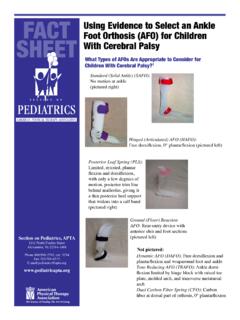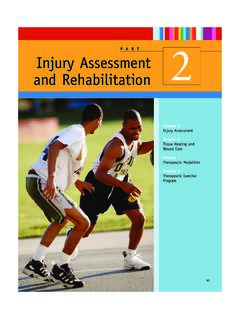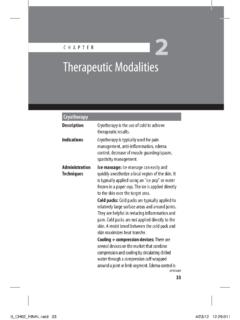Transcription of de Morton Mobility Index (DEMMI) - University of …
1 De Morton Mobility Index ( demmi ). 0 1 2. easiest Bed 1. Bridge unable able sit unsupported 2. Roll onto side unable able 3. Lying to sitting unable min assist independent bridge supervision Chair stand unsupported 4. Sit unsupported in chair unable 10 sec 5. Sit to stand from chair unable min assist independent sit to stand supervision 6. Sit to stand without using arms unable able Static balance (no gait aid) roll 7. Stand unsupported unable 10 sec 8. Stand feet together unable 10 sec lie to sit 9. Stand on toes unable 10 sec 10. Tandem stand with eyes closed unable 10 sec standing feet together Walking 11. Walking distance +/- gait aid unable 10m 50m pick up pen from floor Gait aid (circle): nil/frame/stick/other 5m 20m 12.
2 Walking independence unable independent independent walks backwards min assist with gait aid without gait aid supervision walking distance Dynamic balance (no gait aid). 13. Pick up pen from floor unable able sit to stand no arms 14. Walks 4 steps backwards unable able 15. Jump unable able walking independence COLUMN TOTAL SCORE: jump RAW SCORE TOTAL. stand on toes (sum of column total scores) /19. demmi SCORE tandem stand eyes closed (MDC90 = 9 points; MCID = 10 points) /100 hardest Raw- demmi Score Conversion Table Raw Score 0 1 2 3 4 5 6 7 8 9 10 11 12 13 14 15 16 17 18 19. demmi score 0 8 15 20 24 27 30 33 36 39 41 44 48 53 57 62 67 74 85 100. Comments: Signature:_____ Date:_____.
3 ITEM INSTRUCTIONS PROTOCOL FOR ADMINISTRATION OF THE demmi . Bed 1. Testing should be performed at the person's bedside. 1. Person is lying supine and is asked to bend their knees and lift their bottom clear of the 2. Testing should be performed when the person has adequate medication eg. at least half bed. an hour after pain or Parkinson's Disease medication. 2. Person is lying supine and is asked to roll onto one side without external assistance. 3. The test should be administered in the sequence described in sections A-E: bed 3. Person is lying supine and is asked to sit up over the edge of the bed. transfers, chair transfers, static balance, walking and dynamic balance.
4 4. Each item should be explained and, if necessary, demonstrated to the person. Chair 5. Items should be ticked to indicate item success or failure. Reasons for not testing items 4. Person is asked to maintain sitting balance for 10 seconds while seated on the chair, should be recorded. without holding arm rests, slumping or swaying. Knees and feet are placed together and 6. Items should not be tested if either the test administrator or the person performing the feet can be resting on the floor. test are reluctant to attempt the item. 5. Person is asked to rise from sitting to standing using the arm rests of the chair. 7. Persons should be scored based on their first attempt.
5 6. Person is asked to stand with their arms crossed over their chest. 8. If an item is not appropriate given a person's medical condition, the item should not be tested and the reason recorded. Static Balance 9. Persons can be encouraged but feedback should not be provided regarding 7. The person is asked if they can stand for 10 seconds without external support. performance. 8. The person is asked if, for 10 seconds, they can stand with their feet together. 10. Three equipment items are required: chair with 45cm seat height with arm rests, a 9. The person is asked if they can stand on their toes for 10 seconds. hospital bed or plinth and a pen. 10. The person is asked to place the heel of one foot directly in front of the other with their 11.
6 The person administering the test manipulates person medical equipment during testing eyes closed for 10 seconds. (eg. portable oxygen, drips, drains etc) unless the person requires minimal assistance to perform the test and then a 2nd person will be required to assist with medical equipment. Walking 12. For persons that require a rest after each item due to shortness of breath, a 10 minute 11. Persons will be asked to walk with their current gait aid to where they can without a rest. rest should be provided half way through testing after completing the chair transfers Testing ceases if the person stops to rest. The person uses the gait aid that is currently section.
7 Most appropriate for them. If either of two gait aids could be used, the aid that provides 13. For person's who have low level Mobility and require a hoist to transfer in/out of bed or the person with the highest level of independence should be used. Testing ceases once chair, the chair section can be administered before the bed section for these persons. the person reaches 50 meters. 14. Bed transfers: the bed height should be appropriate for the individual person. A. 12. Independence is assessed over the person's maximum walking distance up to 50m (from standardised hospital bed or plinth should be used for testing. The person cannot use an item 11). external device such as the monkey bar, bed rail, edge of bed or a bed pole.
8 Additional pillows may be provided for persons who are unable to lie flat in supine. Dynamic Balance 15. Chair transfers: A standardised chair height of 45cm is required. A firm chair with arms 13. A pen is placed 5 cm in front of the person's feet in standing. The person is asked if they should be used. can pick the pen up off the floor. 16. Balance: Shoes cannot be worn for balance testing. The person cannot use external 14. Walks backwards 4 steps. Person remains steady throughout. support to successfully complete any balance items. For sitting balance, neither the arm 15. Person can jump. Both feet clear the ground. Person remains steady throughout. rests or the back of the chair can be used for external support.
9 Standing balance tests should be performed with the person positioned between an elevated bed on one side and the test administrator on the other side. If a person displays unsteadiness or Definitions significant sway during testing, testing of that item should cease. Minimal assistance = hands on physical but minimal assistance, primarily to guide movement. 17. Walking: Appropriate shoes can be worn for walking tests. The same shoes must be Supervision = another person monitors the activity without providing hands on assistance. May worn for repeat testing. include verbal prompting. 18. Scoring: Using the conversion table provided, the raw score total must be converted to a Independent = the presence of another person is not considered necessary for safe Mobility .
10 demmi SCORE. Copyright de Morton , Davidson & Keating 2007. The demmi may be printed or reproduced without alteration (retaining this copyright notice). All other rights reserved. For other authorisations (including to translate the demmi ) contact Dr Natalie de Morton : The development of the demmi has been supported by a post graduate scholarship from the National Health and Medical Research Council of Australia (Dora Lush Postgraduate Scholarship, Grant no. 280632), funded by the HCF Health and Medical Research Foundation and also supported by The Northern Clinical Research Centre, Northern Health. The demmi should be cited as: de Morton NA, Davidson M, Keating JL.





![[ FACILITY ] LIFT PROGRAM POLICY AND GUIDE](/cache/preview/6/4/e/a/0/b/b/0/thumb-64ea0bb0ff01063ef36407a3244742b9.jpg)

